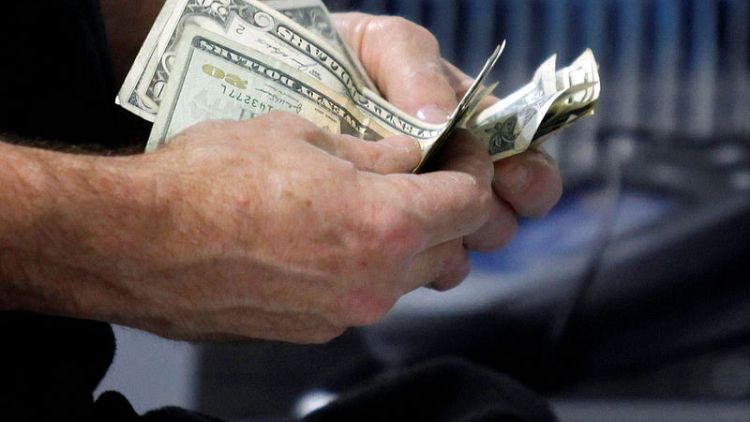By Lucia Mutikani
WASHINGTON (Reuters) - U.S. consumer spending increased marginally in September while wages were unchanged, which could cast doubts on consumers' ability to continue driving the economy amid a deepening slump in business investment.
The report from the Commerce Department on Thursday also showed inflation was muted last month. The data came a day after the Federal Reserve cut interest rates for the third time this year, but signalled a pause in the easing cycle that started in July when it reduced borrowing costs for the first time since 2008.
Fed Chair Jerome Powell said he expected the economy to continue on a moderate growth path, driven by "solid household spending and supportive financial conditions."
Consumer spending, which accounts for more than two-thirds of U.S. economic activity, gained 0.2% last month as households stepped up purchases of motor vehicles and spent more on healthcare, the government said.
Data for August was revised up to show consumer spending climbing 0.2% instead of the previously reported 0.1% rise. Last month's increase in consumer spending was in line with economists' expectations. Consumer spending has slowed since jumping 0.5% in July.
The data was included in the gross domestic product report for the third quarter, which was published on Wednesday.
The government reported that growth in consumer spending slowed to a still-healthy 2.9% annualised rate last quarter after surging at a 4.6% pace in the second quarter, the fastest since the fourth quarter of 2017.
That softened some of the blow on the economy from the second straight quarterly contraction in business investment.
The economy grew at a 1.9% rate in the third quarter after expanding at a 2.0% pace in the April-June period.
U.S. stock index futures were trading slightly lower on Thursday while prices of U.S. Treasuries were higher. The dollar <.DXY> was weaker against a basket of currencies.
JOBLESS CLAIMS RISE
Inflation was tame in September. Consumer prices as measured by the personal consumption expenditures (PCE) price index were unchanged for a second straight month in September as the cost of energy goods and services dropped 1.3%.
In the 12 months through September, the PCE price index increased 1.3% after rising 1.4% in the 12 months through August. Excluding the volatile food and energy components, the PCE price index was also unchanged last month after gaining 0.1% in August. That lowered the annual increase in the so-called core PCE price index to 1.7% in September from 1.8% in August.
The core PCE index is the Fed's preferred inflation measure. It has undershot the U.S. central bank's 2% target this year.
Low inflation and the lowest unemployment rate in nearly 50 years are supporting consumer spending.
In a separate report on Thursday, the Labor Department said initial claims for state unemployment benefits increased 5,000 to a seasonally adjusted 218,000 for the week ended Oct. 26.
Economists polled by Reuters had forecast claims would rise to 215,000 in the latest week.
The four-week moving average of initial claims, considered a better measure of labour market trends as it irons out week-to-week volatility, slipped 500 to 214,750 last week.
While the low levels of claims suggest solid labour market conditions, job growth is expected to have slowed sharply in October because of a 40-day strike by workers at General Motors <GM.N>. Government data last Friday showed 46,000 GM employees were idle at the automaker's plants in Michigan and Kentucky during the October nonfarm payrolls count.
Striking workers who do not receive a paycheck during the payrolls survey period are treated as unemployed. The strike by members of the United Auto Workers union, which ended last Friday, had ripple effects on the auto industry.
Economists estimated the work stoppage cut between 75,000 and 80,000 jobs from October payrolls. As a result, the employment report on Friday will likely show only 89,000 jobs were added in October, down from 136,000 in September, according to a Reuters survey of economists.
The unemployment rate is forecast to rise one-tenth of a percentage point to 3.6%.
Even discounting the GM strike, job growth has been slowing in line with ebbing demand and a shortage of workers. Slowing job growth together with signs wage growth is stalling could raise questions about the health of consumers.
While personal income rose 0.3% in September, it was driven by government subsidies to farmers caught in the U.S.-China trade war. Income jumped 0.5% in the prior month. Wages were unchanged after surging 0.6% in August.
With income growth outpacing spending, savings rose to $1.38 trillion from $1.35 trillion in August.
A third report from the Labor Department showed labour costs increased 0.7% in the third quarter after rising 0.6% in the second quarter. That raised the year-on-year rate of gain in the labour costs to 2.8% from 2.7% in the second quarter.
(Reporting by Lucia Mutikani; Editing by Paul Simao)



